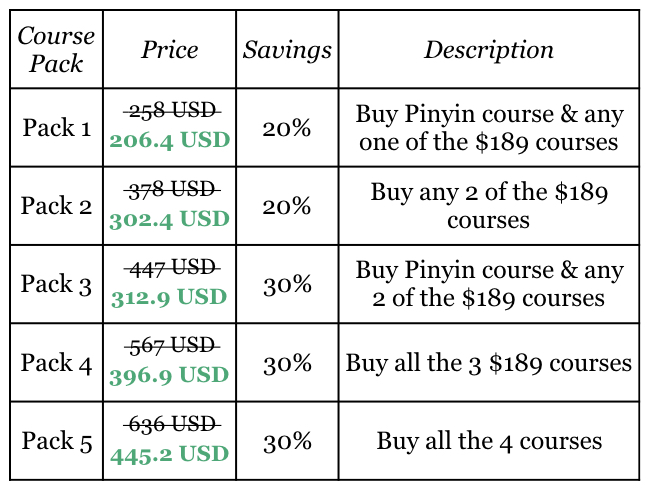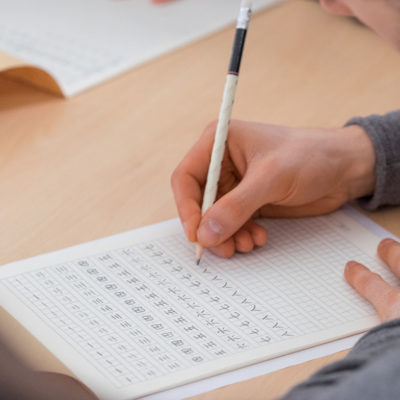Description
WHO IS THIS COURSE FOR?
- This course is for people who don’t know where to start their Chinese learning. Learning correct Chinese pronunciation is always the priority!
- This course is also for people who are not totally beginners. If you want to speak Chinese more clearly, if you have a strong accent, or if you want to better understand native Chinese speakers, this course can help you achieve your goal.
- People who have problems with Chinese tones should take this course.
- People who don’t know how to write in Chinese Pinyin correctly should take this course.
HOW IT WORKS?
- Step 1: Watch a video lecture with detailed and clear explanations of how to make every single Chinese sound and examples of those sounds in words and phrases. You will also learn the phonetic spelling rules for writing Chinese syllables and tone changes.
- Step 2: Listen to and read the Chinese sounds and examples of those sounds in words and phrases online, or you can download the audios and scripts to practice anytime, anywhere.
- Step 3: Take the online quiz to help you master Chinese Pinyin effectively.
WHAT AM I GOING TO GET FROM THIS COURSE?
After working through this course, you will be able to produce every Chinese sound clearly and confidently. You will reduce your accent and sound more like a native speaker. You will hear the difference between words that are similar. You will know how to write in Chinese Pinyin correctly.
COURSE CONTENT
Chinese Language Introduction (Please log in to view this sample lesson)
Lesson 01: (Please log in to view this sample lesson)
- 7 simple finals: a, o, e, i, u, ü, er
- 5 tones: 1st tone, 2nd tone, 3rd tone, 4th tone and neutral tone
- The spelling rules about “i”, “u”, “ü”
Lesson 02
- 4 initials: b, p, m, f
- The Pinyin syllables combined by the 4 initials and the 6 simple finals
- The tone change of the word “不(bù)”
Lesson 03
- 7 initials: d, t, n, l, g, k, h
- The Pinyin syllables combined by the 7 initials and the 6 simple finals
- How the tone changes when two third tone syllables appear together
Lesson 04
- 3 initials: s, c, z
- The Pinyin syllables combined by the 3 initials and the 6 simple finals
- How to pronounce “i” after “s, c, z”
Lesson 05
- 4 initials: sh, ch, zh, r
- The Pinyin syllables combined by the 4 initials and the 6 simple finals
- How to pronounce “i” after “sh, ch, zh, r”
Lesson 06
- 3 initials: x, q, j
- The Pinyin syllables combined by the 3 initials and the 6 simple finals
- The review of all the 21 initials
Lesson 07
- 9 diphthong finals: ao, ai, ou, ei, ie, ia, ua, uo, üe
- The Pinyin syllables combined by the 9 diphthong finals and all the 21 initials
- How to spell “ia”, “ie”, “ua”, “uo”, “üe” when they stand for syllables by themselves
- How to mark tones
Lesson 08
- 4 triphthong finals: iao, iou, uai, uei
- The Pinyin syllables combined by the 4 triphthong finals and all the 21 initials
- How to spell “iao”, “iou”, “uai”, “uei” when they stand for syllables by themselves
- How to spell “iou” and “uei” when they go with the initials
- How to mark tones on the final “iu”
Lesson 09
- 8 nasal simple finals: an, ang, en, eng, in, ing, ün, ong
- The Pinyin syllables combined by the 8 nasal simple finals and all the 21 initials
- How to spell “in”, “ing” and “ün” when they stand for syllables by themselves
Lesson 10
- 8 nasal compound finals: ian, iang, uan, uang, uen, ueng, üan, iong
- How to spell the 8 nasal compound finals when they stand for syllables by themselves
- The Pinyin syllables combined by the 8 nasal compound finals and all the 21 initials





